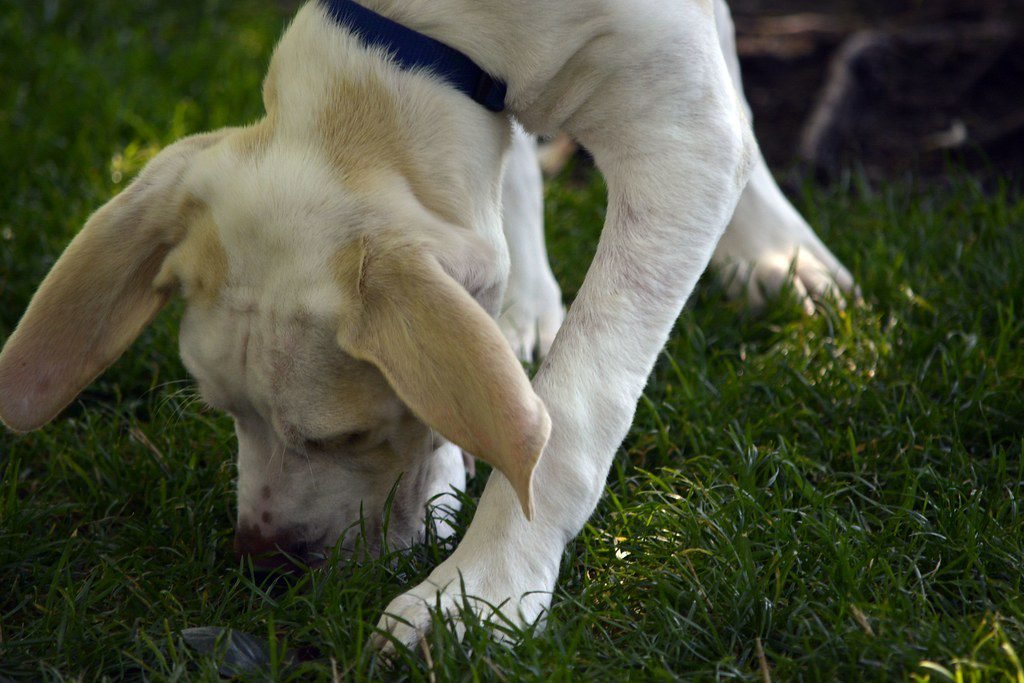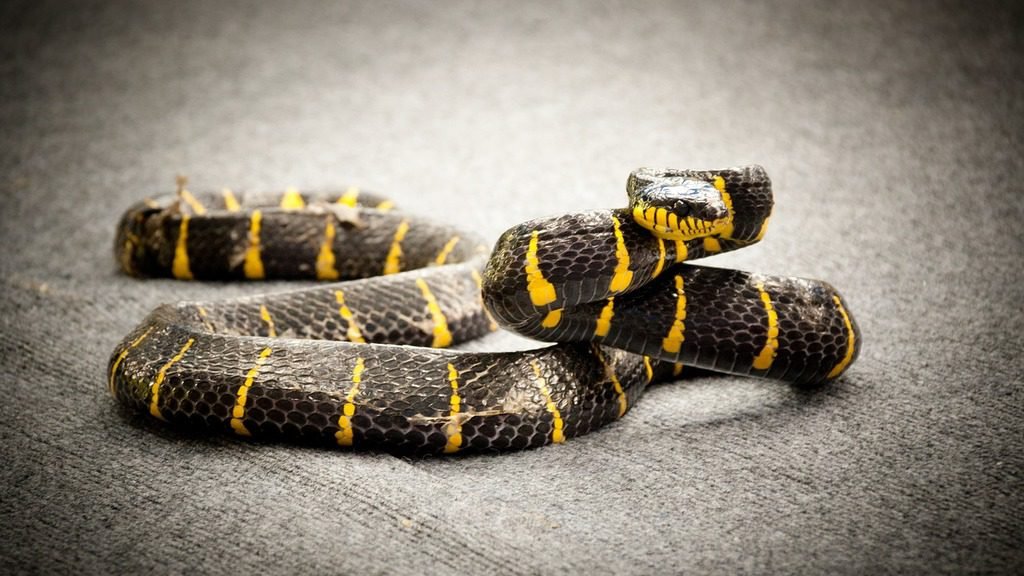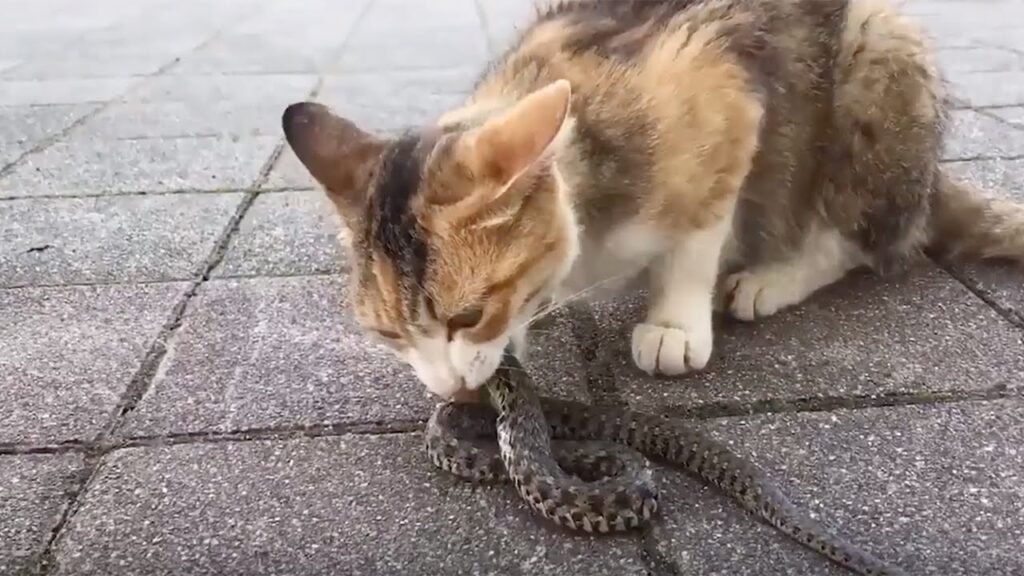


Are Snakes Faster Than Humans? [Fastest Snakes Compared]
February 26, 2024


Can Garter Snakes Hurt Dogs? [Answered]
February 26, 2024Dogs have a fantastic sense of smell, way better than humans. This makes people wonder, can dogs smell snakes? We’re diving into this interesting question to see if dogs can pick up the scent of snakes.
We’ll look at how dogs’ noses work, how they act around snakes, and if some dogs are better at smelling snakes than others. Plus, we’ll talk about why it’s good for dogs to notice snakes and how to keep your dog safe from them.
But first, here’s a quick answer: Yes, dogs can smell snakes. Their superior sense of smell allows them to detect the unique scent of snakes, even at a distance, and sense if the snake is venomous or not. This ability varies among breeds and individual dogs, often influenced by training and instinct. While not all dogs will react the same way to snakes, many can sense their presence, making them valuable for safety in snake-prone areas.
What Makes a Dog’s Sense of Smell So Special?
Dogs possess an extraordinary sense of smell, resulting from biological and evolutionary adaptations that make them unparalleled scent detectors in the animal kingdom.
What sets a dog’s sense of smell apart are several key factors:
Biological factors:
- Olfactory Receptors: Dogs have up to 300 million olfactory receptors in their noses, in stark contrast to humans, who have about 6 million. This vast number of receptors significantly amplifies their ability to detect and distinguish a wide array of scents.
- Brain Power: The part of a dog’s brain that analyzes smells is proportionally 40 times greater than that of humans. This allows dogs to identify and remember a myriad of different odors.
- Jacobson’s Organ: Also known as the vomeronasal organ, this unique structure in the nasal cavity picks up pheromones, chemicals that play a crucial role in animal communication. This organ enhances their detection capabilities beyond just odors, helping them sense emotional states or the reproductive status of other animals.
Evolutionary factors:
- Survival Mechanism: Throughout evolution, a keen sense of smell has been crucial for dogs’ ancestors for various survival tasks, such as hunting, tracking prey, avoiding predators, and locating mates. This necessity drove the development of their exceptional olfactory abilities.
- Domestication and Selective Breeding: Human influence through selective breeding has refined these olfactory capabilities in certain breeds, especially those developed for specific tasks like hunting, tracking, or search and rescue operations.


Dog Sniffing
Also, Read: Do Dog Whistles Hurt Dogs? Myth Busted
How Do Dogs React to Snakes?
Dogs can exhibit various behaviors when encountering snakes, influenced mainly by their curiosity, instinct, and training. Their reactions may vary from cautious interest to aggressive confrontation.
Curiosity
Investigating: Sniffing and pawing at the snake to explore and understand this new creature.
Fear or Caution
Barking: Loud, continuous barking to alert their owners or to intimidate the snake.
Retreating: Stepping back or running away from the snake if they sense danger or are scared.
Aggression
Attacking: Attempting to bite or paw at the snake, especially if they feel threatened or are trained to protect.
Alerting
Whining or Howling: Communicating discomfort or seeking attention from their owner to indicate something unusual.
Playfulness
Play Bowing: Some dogs may misinterpret a snake as a play object, inviting it to engage with a bowed front and wagging tail, unaware of the potential danger.


Venemous Snake
Must Read: Cat or dog? Are cats cleaner than dogs?
What’s the science behind dogs sensing snakes through smell?
Dogs’ remarkable sense of smell enables them to detect snake musk, a defense mechanism snakes use to ward off predators, from significant distances and well after its release. Beyond musk, dogs can also identify the inherent scent of snakes and other reptiles, which remains invisible to humans.
Can dogs smell venomous and non-venomous snakes?
Research published in Applied Animal Behavior Science highlights that dogs can distinguish between the scents of venomous and non-venomous snakes, such as rattlesnakes and boa constrictors. Rather than fear, curiosity often drives dogs toward these scents, increasing their risk of snakebite encounters as their investigation may provoke a defensive attack from the snake.
Editor’s Pick: Are Snakes Faster Than Humans? [Fastest Snakes Compared]
Can you train your dog to detect a snake via smell?
Yes, you can train your dog to detect snakes by utilizing their keen sense of smell. This training can enhance safety by alerting you to snakes, potentially preventing dangerous encounters.
Here’s a basic overview of the training methods used:
Introduction to snake scent
- Start with Snake Sheddings: Begin by introducing your dog to the scent of snakes using shed snakeskin or a safe, non-venomous snake under controlled conditions. This helps your dog recognize the specific smell.
- Use Scented Objects: Place the snake scent on various objects and hide them. This teaches your dog to associate the smell with the task of searching.
Positive reinforcement
- Rewards: Whenever your dog successfully identifies and reacts to the snake scent, immediately reward them with treats, praise, or play. This reinforces the desired behavior.
- Consistency: Regular, short training sessions help reinforce the scent association and desired reaction.
Controlled exposure
- Non-venomous Snakes: Use live, non-venomous snakes for training under professional supervision. This helps your dog learn in a more realistic scenario without the risk.
- Safety First: Always prioritize safety by using a professional trainer experienced in handling snakes if you’re introducing your dog to live snakes.
Specific commands
- Teach Specific Reactions: Train your dog to react in a specific way when they detect a snake, such as sitting, barking, or returning to you. This clear reaction can alert you to the presence of a snake.


The benefits of training a dog to detect snakes by smelling
Having dogs that can detect snakes offers significant advantages, enhancing safety for humans and pets in environments where snakes pose a risk. These benefits extend from personal safety to broader ecological impacts.
- Increased Safety: Dogs can alert their owners to the presence of snakes, reducing the risk of surprise encounters that could lead to bites or other injuries.
- Protection for Pets: Dogs trained to recognize snakes can avoid or alert their owners about dangerous areas, protecting themselves and other pets from potential harm.
- Conservation Efforts: By identifying snakes without harming them, dogs can contribute to wildlife conservation, aiding in the study and protection of snake populations.
- Peace of Mind: Knowing a dog can detect snakes provides peace to people living in or visiting snake-prone areas, especially in outdoor activities like hiking or camping.
- Preventative Measures: Early detection allows for the safe removal of snakes from residential areas, minimizing the need for lethal control methods and promoting coexistence with wildlife.
- Educational Value: Dogs detecting snakes can serve as an educational tool, teaching communities about snakes, their role in the ecosystem, and how to coexist safely.
Recommended Reading: Can Snakes Taste Air? [Detailed Guide]
Are all dog species good at smelling snakes?
Not all dogs are equally proficient at smelling snakes. The ability of a dog to detect snakes through scent can vary significantly across breeds, training, and experience.
Here’s a closer look at these factors:
Breed differences
- Olfactory Capabilities: Some breeds have more developed olfactory capabilities due to their breeding history. For instance, hunting and working breeds like Bloodhounds, Beagles, and Labrador Retrievers have an enhanced sense of smell, making them more adept at detecting snakes and other scents than breeds bred for companionship or other purposes.
- Physical Attributes: The physical structure of a dog’s nose can also impact their smelling abilities. Breeds with longer snouts generally have a larger area dedicated to olfactory processing, which can aid in detecting snakes.
Training
- Specialized Training: Dogs with specialized training to detect snakes are likelier to excel at this task than untrained dogs. The effectiveness of a dog’s ability to smell snakes can greatly depend on the quality and consistency of their training.
- Experience: Dogs with more experience in tracking or working in environments where snakes are common may develop a heightened ability to detect them, regardless of their breed.
Experience
- Exposure: Dogs frequently exposed to snake scents, especially in training, tend to become more skilled at identifying these scents over time.
- Learning Curve: Dogs can improve their ability to detect snakes with continued exposure and positive reinforcement, enhancing their effectiveness through practical experience.
Next Read: Can snakes be pets? (Do they like being a pet?) Pros/Cons


Caucasian Shepherd
FAQs
How to keep your dog safe from snakes?
Keeping your dog safe from snakes involves proactive measures, including training, supervision, and modifying the environment around your home to minimize risks.
Here are practical tips to help prevent dangerous encounters:
- Snake Avoidance Training: Enroll your dog in a snake avoidance training program to teach them to recognize and avoid snakes.
- Obedience Training: Ensure your dog is well-trained to respond to commands, such as “leave it” or “come,” to control their actions during a potential snake encounter.
- Leash Walks: Keep your dog on a leash during walks in snake-prone areas to prevent them from exploring dangerous spots.
- Close Monitoring: Closely monitor your dog when they are outside, especially in areas known for snake activity.
- Clean Up: Remove debris, tall grass, and wood piles from your yard, as these can be attractive hiding spots for snakes.
- Fencing: Consider installing snake-proof fencing around your property or play areas to deter snakes from entering.
- Avoid Water Bodies: Keep your dog away from water bodies like ponds or lakes in snake-prone areas, as snakes often frequent these habitats.
- Check Regularly: Inspect your property for snakes or signs of snakes, especially during warmer months when they are more active.
- Educate Yourself: Learn about the types of snakes common in your area and their behavior to better anticipate and avoid encounters.
Can snake detection training be stressful for dogs?
Snake detection training, when done correctly, focuses on positive reinforcement and safety, minimizing stress. Professional trainers use methods that ensure the dog’s comfort and confidence, initially introducing them to snake scents without direct exposure to live snakes, making the process informative and stress-free.
How effective is snake-proof fencing?
Snake-proof fencing can be highly effective, with small mesh sizes and buried edges to prevent snakes from entering. Regular maintenance is crucial to ensure there are no gaps or holes. While not 100% foolproof, such fencing significantly reduces the chances of snakes entering designated areas.
Are certain times of year more dangerous for snake encounters?
Yes, snake encounters are more common in warmer months, especially spring and summer, when snakes are most active. During these times, snakes are out hunting and may be more visible, increasing the likelihood of encounters with pets and humans. Extra vigilance and precaution are advised during these periods.
Can dogs be trained to detect specific types of snakes?
During training sessions, dogs can be trained to detect specific types of snakes by using scent samples from those species. This specialized training enables dogs to alert their owners to the presence of particular snakes, such as venomous species, making them invaluable for safety in specific environments.
Conclusion
Dogs’ remarkable olfactory skills enable them to detect snakes, highlighting a unique connection between canine instincts and wildlife. Training enhances these innate abilities, offering safety benefits in snake-prone areas.
This blog highlights the importance of harnessing dogs’ natural talents for mutual coexistence among dogs, humans, and snakes. Let’s appreciate our furry friends’ instincts and foster environments where all can thrive together, minimizing risks and promoting harmony with nature.



